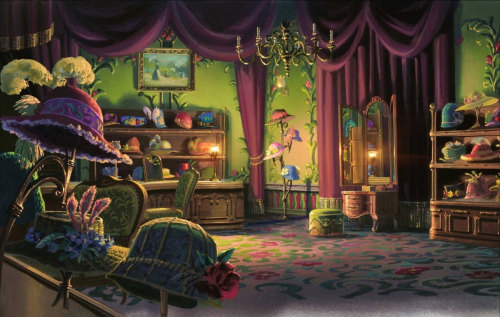Earlier This Year, The Lutetium Project Explored How Microfluidic Circuits Are Made, And Now They Are

Earlier this year, The Lutetium Project explored how microfluidic circuits are made, and now they are back with the conclusion of their microfluidic adventures. This video explores how microfluidic chips are used and how microscale fluid dynamics relates to other topics in the field. Because these techniques allow researchers very fine control over droplets, there are many chemical and biological possibilities for microfluidic experiments, some of which are shown in the video. Microfluidics in medicine are also already more common than you may think. For example, test strips used by diabetic patients to measure their blood glucose levels are microfluidic circuits! (Video and image credit: The Lutetium Project; submitted by Guillaume D.)
More Posts from Smparticle2 and Others










Howl’s Moving Castle, 2004










Dead Poets Society (1989)
Director - Peter Weir, Cinematography - John Seale
“Boys, you must strive to find your own voice. Because the longer you wait to begin, the less likely you are to find it at all. Thoreau said, "Most men lead lives of quiet desperation.” Don’t be resigned to that. Break out!“

Black phosphorus holds promise for the future of electronics
Discovered more than 100 years ago, black phosphorus was soon forgotten when there was no apparent use for it. In what may prove to be one of the great comeback stories of electrical engineering, it now stands to play a crucial role in the future of electronic and optoelectronic devices.
With a research team’s recent discovery, the material could possibly replace silicon as the primary material for electronics. The team’s research, led by Fengnian Xia, Yale’s Barton L. Weller Associate Professor in Engineering and Science, is published in the journal Nature Communications April 19.
With silicon as a semiconductor, the quest for ever-smaller electronic devices could soon reach its limit. With a thickness of just a few atomic layers, however, black phosphorus could usher in a new generation of smaller devices, flexible electronics, and faster transistors, say the researchers.
That’s due to two key properties. One is that black phosphorus has a higher mobility than silicon—that is, the speed at which it can carry an electrical charge. The other is that it has a bandgap, which gives a material the ability to act as a switch; it can turn on and off in the presence of an electric field and act as a semiconductor. Graphene, another material that has generated great interest in recent years, has a very high mobility, but it has no bandgap.
Read more.

Wanting to feel productive, the grad student prints multiple articles with reckless abandon.

“I was on a leadership team in 5th grade. At the end of the year we were supposed to take a trip to Washington DC. We held fundraisers and everything. But when it was time to go, I didn’t have the identification papers to buy a plane ticket. So our teacher Ms. Rivera decided that we’d take a bus. Just so I could go too. That trip changed my life. It made me want to be a lawyer. And Ms. Rivera became one of the closest people in my life. She always kept in touch. She basically watched me grow up. One time in high school I got in a huge fight with my mom, and Ms. Rivera came and took me on a long car ride. I started to tell her everything. I told her about a recent break-up, and how I smoked weed, and ‘I did this,’ and ‘I did that.’ She just listened to everything. Then she started telling me about her life too. She told me that she’d been in an abusive relationship. I’d always thought her life was perfect because she was a guidance counselor. But she’d been through so much too. When it was came time to apply for college, Ms. Rivera was the one who helped me apply for DACA. She told me about the TheDream.us scholarship. I didn’t even want to apply. I was ready to give up. I’d just accepted that I’d always work in restaurants like my mom. But Ms. Rivera made me apply. She said: ‘What happened to that girl who wanted to be a lawyer?’ I learned that I got the scholarship in February. They’re paying for my entire college. Ms. Rivera was so proud of me. She kept saying: ‘I told you so.’”







How to Beam ➝ Noemi Makra Style

Sunday’s are for relaxing with a good book.


“Before a scene, she would be muttering deprecations under her breath and making small moans. According to Vivien, the situation was stupid, the dialogue was silly, nobody could possibly believe the whole scene. And then…she would walk into the scene and do such a magnificent job that everybody on the set would be cheering.” -David O. Selznick




-
 m00ndingochan reblogged this · 3 years ago
m00ndingochan reblogged this · 3 years ago -
 profanities-of-common-sense reblogged this · 4 years ago
profanities-of-common-sense reblogged this · 4 years ago -
 m00ndingochan reblogged this · 4 years ago
m00ndingochan reblogged this · 4 years ago -
 usedcarheaven liked this · 4 years ago
usedcarheaven liked this · 4 years ago -
 m00ndingochan reblogged this · 4 years ago
m00ndingochan reblogged this · 4 years ago -
 techjum reblogged this · 4 years ago
techjum reblogged this · 4 years ago -
 m00ndingochan reblogged this · 5 years ago
m00ndingochan reblogged this · 5 years ago -
 m00ndingochan reblogged this · 5 years ago
m00ndingochan reblogged this · 5 years ago -
 anarchagland liked this · 6 years ago
anarchagland liked this · 6 years ago -
 throbbingpain liked this · 6 years ago
throbbingpain liked this · 6 years ago -
 nev-mind liked this · 6 years ago
nev-mind liked this · 6 years ago -
 beelzebunny liked this · 6 years ago
beelzebunny liked this · 6 years ago -
 m00ndingochan reblogged this · 6 years ago
m00ndingochan reblogged this · 6 years ago -
 vulpeko reblogged this · 6 years ago
vulpeko reblogged this · 6 years ago -
 socramirus liked this · 6 years ago
socramirus liked this · 6 years ago -
 polka-dots-polka-spots reblogged this · 6 years ago
polka-dots-polka-spots reblogged this · 6 years ago -
 sartenindomable liked this · 7 years ago
sartenindomable liked this · 7 years ago -
 void-latte liked this · 7 years ago
void-latte liked this · 7 years ago -
 curiosity-killed-the-kat liked this · 7 years ago
curiosity-killed-the-kat liked this · 7 years ago -
 skthproductions liked this · 7 years ago
skthproductions liked this · 7 years ago -
 gravelbar liked this · 7 years ago
gravelbar liked this · 7 years ago -
 jaredthatisall liked this · 7 years ago
jaredthatisall liked this · 7 years ago -
 throwbackjoe reblogged this · 7 years ago
throwbackjoe reblogged this · 7 years ago -
 gloomiersteak liked this · 7 years ago
gloomiersteak liked this · 7 years ago -
 sentimentalsearcher liked this · 7 years ago
sentimentalsearcher liked this · 7 years ago -
 wompwomp690 reblogged this · 7 years ago
wompwomp690 reblogged this · 7 years ago -
 nattryon reblogged this · 7 years ago
nattryon reblogged this · 7 years ago -
 echoatmidnight liked this · 7 years ago
echoatmidnight liked this · 7 years ago -
 sueanoi reblogged this · 7 years ago
sueanoi reblogged this · 7 years ago -
 freddyoakland reblogged this · 7 years ago
freddyoakland reblogged this · 7 years ago -
 freddyoakland liked this · 7 years ago
freddyoakland liked this · 7 years ago -
 chazmoxxx liked this · 7 years ago
chazmoxxx liked this · 7 years ago -
 pinkprogram reblogged this · 7 years ago
pinkprogram reblogged this · 7 years ago -
 plethodon-uncia reblogged this · 7 years ago
plethodon-uncia reblogged this · 7 years ago -
 plethodon-uncia liked this · 7 years ago
plethodon-uncia liked this · 7 years ago -
 zeshuetoral reblogged this · 7 years ago
zeshuetoral reblogged this · 7 years ago -
 zeshuetoral liked this · 7 years ago
zeshuetoral liked this · 7 years ago -
 surgikos liked this · 7 years ago
surgikos liked this · 7 years ago -
 max-fou reblogged this · 7 years ago
max-fou reblogged this · 7 years ago -
 max-fou liked this · 7 years ago
max-fou liked this · 7 years ago -
 realcleverscience reblogged this · 7 years ago
realcleverscience reblogged this · 7 years ago -
 toadscholar liked this · 7 years ago
toadscholar liked this · 7 years ago -
 adams2012 liked this · 7 years ago
adams2012 liked this · 7 years ago -
 philllgood-blog reblogged this · 7 years ago
philllgood-blog reblogged this · 7 years ago -
 philllgood-blog liked this · 7 years ago
philllgood-blog liked this · 7 years ago -
 sweetheart-ninja liked this · 7 years ago
sweetheart-ninja liked this · 7 years ago -
 electron-micronaut liked this · 7 years ago
electron-micronaut liked this · 7 years ago